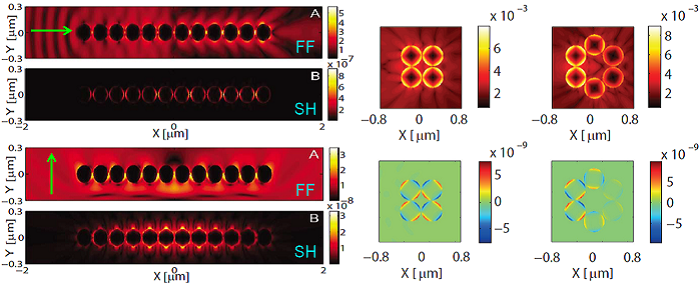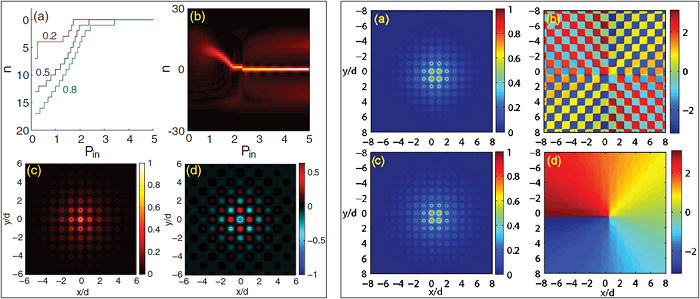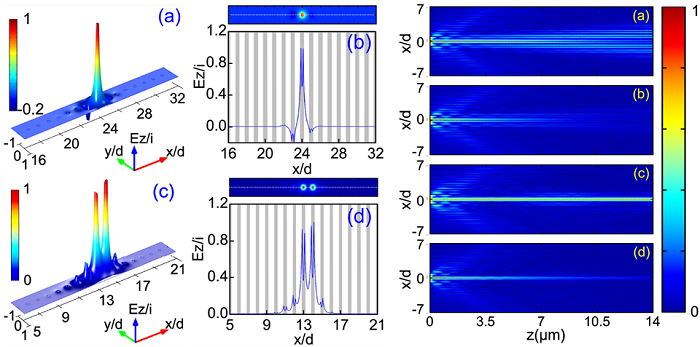
|
 |
Second-Harmonic Generation in Ensembles of Metallic Nanowires
|
One
of the most important properties of plasmonic nanostructures is the
strong optical near-field enhancement induced by the interaction with
electromagnetic waves, an effect that is usually a consequence of the
resonant excitation of surface-plasmon polaritons. As a result, one can induce
strong nonlinear optical effects at a moderate optical power. In this
context, we have recently developed a comprehensive theoretical
description based on the multiple-scattering matrix formalism of the second
harmonic generation (SHG) in metamaterials consisting of arbitrary
distributions of cylindrical nanowires made of centrosymmetric
materials, such as metals. Our theory allows one to calculate the
electromagnetic field at both the fundamental frequency and second
harmonic, as well as the total cross section, the absorption cross
section, and the scattering cross section. In particular, our formalism
fully describes the nonlinear optical response of the metamaterial by
incorporating the contributions of both the surface and bulk nonlinear
polarizations and can be applied to both s- and p-polarized
incident waves. We have used this theoretical method and its numerical
implementation to investigate the SHG in a series of particular cases
of practical interest, namely, a single metallic cylinder, chains of
metallic cylinders, periodic and random distributions of such
cylinders, and plasmonic cavities. In particular, we have studied the
relation between the local field enhancement, via
the excitation of surface plasmon-polariton modes, and the amount of
energy absorbed or scattered in the far-field, at the fundamental
frequency and second harmonic. As a possible technological
application of these ideas, we have investigated the feasibility of
using nonlinear modes of plasmonic cavities to design ultra-compact
plasmonic sensors with enhanced sensitivity. More information about this topic can be found here.
|

|
Relevant publications:
- C. G. Biris and N. C. Panoiu, Second Harmonic Generation in Metamaterials based on Homogeneous Centrosymmetric Nanowires, Phys. Rev. B 81, 195102 (2010) (also selected by the editors of Phys. Rev. B to be an Editors' Suggestion). [pdf]
- C. G. Biris and N. C. Panoiu, Nonlinear pulsed excitation of high-Q optical modes of plasmonic cavities made of metallic nanowires, Opt. Express 18, 17165 (2010) (also featured in the Virtual Journal of Ultrafast Science 9 (10), October, 2010). [pdf]
- C. G. Biris and N. C. Panoiu, Excitation of dark plasmonic cavity modes via nonlinearly induced dipoles: applications to near-infrared plasmonic sensing, Nanotechnology 22, 235502 (2011). [pdf]
- C. G. Biris and N. C. Panoiu, Excitation of Linear and Nonlinear Cavity Modes upon Interaction of Femtosecond Pulses with Arrays of Metallic Nanowires, Appl. Phys. A: Materials Science & Processing 103, 863 (2011). [pdf]
- C. G. Biris and N. C. Panoiu, Nonlinear Surface-Plasmon Whispering-Gallery Modes in Metallic Nanowire Cavities, Phys. Rev. Lett. 111, 203903 (2013). [pdf]
|
|
|
|
| Plasmonic Solitons and Vortices in Arrays of Metallic Nanowires |
Recently we predicted
theoretically that stable subwavelength plasmonic lattice solitons are
formed in arrays of metallic nanowires embedded in a nonlinear optical medium.
More specifically, in this project, which is a collaboration with Dr. Fangwei Ye from the Physics Department of Shanghai Jiao Tong University,
we have demonstrated that the tight confinement of the guiding modes of
the metallic nanowires, combined with the strong optical nonlinearity
induced by the enhanced field at the metal surface, provide the main
physical mechanisms for balancing the wave diffraction and the
formation of plasmonic lattice solitons (see the left panels below). As
the conditions required for the formation of plasmonic lattice solitons
are satisfied in a variety of plasmonic systems, we expect these
nonlinear modes to have important applications to subwavelength
nanophotonics. In particular, we demonstrated that the subwavelength
plasmonic lattice solitons can be used to optically manipulate with
nanometer accuracy the power flow in ultracompact photonic systems. In
addition, we have shown that 2D plasmonic arrays support more complex
nonlinear modes, namely stable optical vortices, which perhaps
represents the first example of subwavelength vortex solitons (see the
right panels below).
|

|
Relevant publications:
- F. Ye, D. Mihalache, B. Hu, and N. C. Panoiu, Subwavelength Plasmonic Lattice Solitons in Arrays of Metallic Nanowires, Phys. Rev. Lett. 104, 106802 (2010) (also featured in the Virtual Journal of Nanoscale Science and Technology 21 (12), March 22, 2010). [pdf]
- F. Ye, D. Mihalache, B. Hu, and N. C. Panoiu, Subwavelength vortical plasmonic lattice solitons, Opt. Lett. 36, 1179 (2011) (also featured in the Virtual Journal of Nanoscale Science and Technology 23 (16), April 25, 2011). [pdf]
- F. Ye, D. Mihalache, and N. C. Panoiu, Sub-wavelength Plasmonic Solitons in 1D and 2D Arrays of Coupled Metallic Nanowires, in Spontaneous Symmetry Breaking, Self-Trapping, and Josephson Oscillations, Ed. B. A. Malomed (Progress in Optical Science and Photonics, Vol. 1, Springer, Berlin, Germany, 2013). [pdf]
|
|
|
|
| Anderson Localization in Arrays of Plasmonic Nanowires |
| Using
a generic example of a disordered plasmonic system, namely an array of
coupled, randomly perturbed metallic nanowires, we have recently
demonstrated that structural disorder can induce light localization at
deep-subwavelength scale in plasmonic nanostructures. Our theoretical
and computational analysis is based on solving the complete set of
three-dimensional Maxwell equations and thus it provides a rigorous
description of the dynamics of the plasmonic field at the nanoscale. We
have found that a random variation of the radius of coupled plasmonic
nanowires leads to the Anderson localization of the collective
excitation of surface-plasmon polaritons, the characteristic localization length of
these disorder-induced optical modes being significantly smaller than the
wavelength. Remarkably, our analysis shows that the optical gain
coefficient needed to compensate the optical losses in the plasmonic
components of the system is much smaller than the loss coefficient of
the metal, a finding that can be extremely relevant for experimental
investigations of Anderson localization in plasmonic nanostructures.
The excitation and propagation of Anderson localized surface-plasmon
polaritons have also been addressed. This work is a collaboration with Dr. Fangwei Ye from the Physics Department of Shanghai Jiao Tong University and Prof. Boris Malomed from the School of Electrical Engineering of Tel Aviv University. |

|
Relevant publications:
- X. Shi, F. Ye, X. Chen, B. A. Malomed, and N. C. Panoiu, Anderson localization at the subwavelength scale for surface plasmon polaritons in disordered arrays of metallic nanowires, Phys. Rev. B 89, 195428 (2014). [pdf]
- H. Deng, X. Chen, B. A. Malomed, N. C. Panoiu, and F. Ye, Transverse Anderson localization of light near Dirac points of photonic nanostructures, Sci. Rep. 5, 15585 (2015). [pdf]
- H. Deng, X. Chen, B. A. Malomed, N. C. Panoiu, and Fangwei Ye, Tunability and Robustness of Dirac Points of Photonic Nanostructures (invited), IEEE J. Sel. Topics Quantum Electron. 22, 5000509 (2016). [pdf]
|
|
|
|
| Quantum Interaction between Molecules and Plasmonic Metamolecules |
Recently
there has been an increasing interest in the physics of light matter
interaction at the nanoscale. In particular, quantum plasmonics is
emerging as an ideal field where such new ideas and phenomena can be
studied, primarily because plasmonic nanostructures facilitate an
enhanced coupling between light and matter. In this context, we have
proposed a quantum mechanical model that fully describes the
interaction between molecules and plasmonic metamolecules (plasmonic
structures that have a series of optical resonances). More
specifically, in collaboration with Dr. Paul Warburton's group at the London Centre for Nanotechnology,
we have demonstrated that the coupling between tunable broadband modes
of an array of plasmonic metamolecules and a vibrational mode of
carbonyl bond of poly(methyl methacrylate) produces a Fano-like
resonance, which can be tuned in situ by varying the polarization of
the incident light. The interaction between the plasmon modes and the
molecular resonance was investigated using both rigorous
electromagnetic calculations and a quantum mechanical model describing
the quantum interference between a discrete state (the vibrational mode
of the molecule) and two continua (the broad plasmon resonances). The
predictions of the quantum mechanical model were in good agreement with
the experimental data and provided an intuitive interpretation, at the
quantum level, of the plasmon molecule coupling.
|

|
Relevant publications: E. J. Osley, C. G. Biris, P. G. Thompson, R. R. F. Jahromi, P. A. Warburton, and N. C. Panoiu, Fano Resonance Resulting from a Tunable Interaction between Molecular Vibrational Modes and a Double Continuum of a Plasmonic Metamolecule, Phys. Rev. Lett. 110, 087402 (2013). [pdf]
|
|
|





